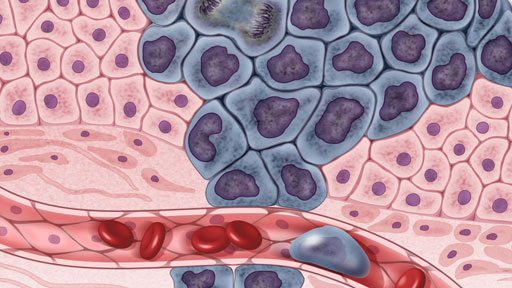They found that the disease - chromophobe renal cell carcinoma (ChRCC) - stems in part from alterations in genes in the mitochondria, the cell's energy supplier. They also discovered that the tumor is characterized by genetic rearrangements near a gene important in DNA repair and in maintaining telomerase, the enzyme which determines a cell's lifespan. Finally, investigators also found that ChRCC is a distinct disease and shares few genomic characteristics with other kidney cancers.
In the study - the most extensive genomic view of ChRCC to date - investigators led by Chad Creighton, Ph.D., Baylor College of Medicine, Houston, and Kimryn Rathmell, M.D., Ph.D., University of North Carolina, Chapel Hill, performed a complex array of analyses, including examining the entire genomes of 50 of the 66 ChRCC tumors studied, a high number for a rare cancer.
The study revealed increased numbers of mitochondria as well as mutations in mitochondrial DNA. This led researchers to discover that ChRCC tumors favor a different energy-generating process than that used by the more common clear cell kidney cancer. In addition, their findings are the first to show specific alterations affecting the TERT gene that could affect cancer development, and might help explain its increased expression - and deregulation - in cancer. Overall, the findings provide new insights into the development of more common forms of kidney cancer, and shed light on the role of mitochondria and metabolic pathways in cancer. The results also support the growing realization that both the cancer's genomic characteristics and cell of origin matter, as many cancers consist of several individual diseases that require specific therapies.
TCGA is a collaboration jointly supported and managed by the National Cancer Institute (NCI) and the National Human Genome Research Institute (NHGRI), both parts of the National Institutes of Health. The researchers reported their results online August 21, 2014 in Cancer Cell.
ARTICLE:
Davis, et al. The somatic genomic landscape of chromophobe renal cell carcinoma. Cancer Cell. DOI: 10.1016/j.ccr.2014.07.014 (2014)
WHO:
Carolyn Hutter, Ph.D., program director, Division of Genomic Medicine, NHGRI
CONTACT:
To schedule an interview, please contact Steven Benowitz, NHGRI, 301-451-8325, or steven.benowitz@nih.gov.
NHGRI is one of the 27 institutes and centers at the National Institutes of Health. The NHGRI Extramural Research Program supports grants for research and training and career development at sites nationwide. Additional information about NHGRI can be found at http://www.genome.gov.
NCI leads the National Cancer Program and the NIH effort to dramatically reduce the burden of cancer and improve the lives of cancer patients and their families, through research into prevention and cancer biology, the development of new interventions, and the training and mentoring of new researchers. For more information about cancer, please visit the NCI website at http://www.cancer.gov or call NCI's Cancer Information Service at 1-800-4-CANCER (1-800-422-6237).
About the National Institutes of Health (NIH): NIH, the nation's medical research agency, includes 27 institutes and centers and is a component of the U.S. Department of Health and Human Services. NIH is the primary federal agency conducting and supporting basic, clinical, and translational medical research, and is investigating the causes, treatments, and cures for both common and rare diseases. For more information about NIH and its programs, visit http://www.nih.gov.



